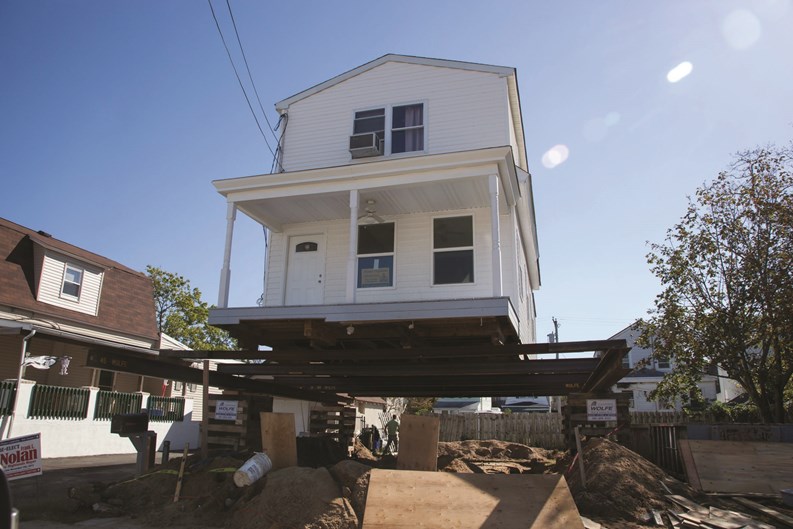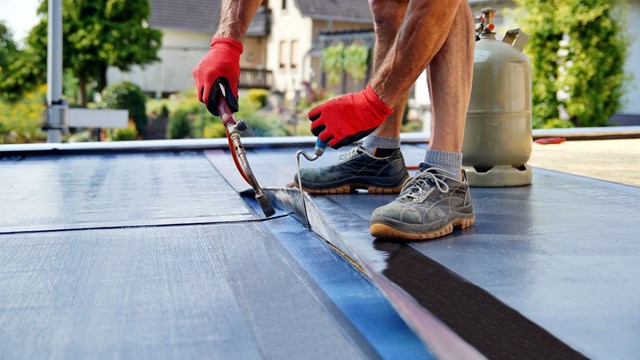Almost five years have passed since Superstorm Sandy slammed the East Coast and caused major havoc and destruction, reportedly resulting in 117 deaths and an estimated $65 billion in damages. For many affected people in New York and New Jersey, the memories of that fateful evening of Oct. 29, 2012 remain, from the loss of electricity and downed trees to forced evacuations and the destruction of homes.
It wasn’t the winds or rain that had the most devastating affect on the city; it was the storm surge. According to the June 2013 report titled “A Stronger, More Resilient New York” published by the City of New York, 51 square miles of the Big Apple were flooded, equaling 17 percent of the city’s total land. The report counted 88,700 buildings in this inundation zone— buildings containing more than 300,000 homes and approximately 23,400 businesses. “In many places, it was not only the extent of flooding that was significant; it was also the depth of floodwaters. Water heights of several feet above ground level were prevalent in many coastal areas. Near Sea Gate, on the Coney Island peninsula in Brooklyn, the water reached 11 feet above ground level, and at Tottenville on Staten Island, they rose to 14 feet.”
In New Jersey, coastal regions in the state were hit hardest, with mandatory evacuations of many towns along the Jersey Shore. Cities along the Hudson River from Jersey City to Hoboken experienced massive flooding as well. One state report said that the event emphasized “the need for a thoughtful and comprehensive long-term recovery process.”
Now as the five-year anniversary of the storm’s arrival approaches, some area residents and communities are still picking up the pieces.
Sandy’s Impact on New York Multifamily Residences
According to the report “Sandy’s Effects on Housing in New York City” by New York University’s Furman Center for Real Estate and Urban Policy, “Of the 302,000 housing units in the surge area, 70 percent are located in multifamily properties with more than 4 units.”
All over the affected areas, buildings that housed more than one residence suffered damages and faced serious repairs. “[It] was on a grander scale,” says Andy Leight, vice president of operations at AKAM Living Services, a property management firm with offices in New York and Florida. “A single-family home is just one family. In a 200 [-unit] apartment building, it’s just a greater number [of people].”
Many of the multifamily residences that experienced flooding suffered loss of electricity, heat and other utilities because boilers and electrical panels were often located in basements, which of course are more likely to take on water during floods. “Although high-rise buildings did not generally experience as much structural damage, they often lost mechanical building equipment housed in basements, rendering buildings uninhabitable and leaving residents stranded on upper floors and businesses closed until repairs could be made,” according to the city’s report.
“Some buildings had no heat, no hot water. Downtown, some buildings didn’t have elevators,” says Leight. “Certainly there was a level of inconvenience … And safety was an issue.”
Sean Almonte is the director of the New York City Housing Preservation and Development Office’s Multifamily Storm Recovery and Resiliency Program, part of the city’s Build It Back program that helps those affected by Sandy rebuild their homes. He says typical work performed on multi-unit buildings in that program included replacement and repair of boilers and electrical systems and drywall, doors, flooring and windows in common areas. Elevator equipment was also repaired or replaced in some instances.
Individual co-op or condo units would be serviced by the program in some cases, Almonte says, but they had to meet a minimum threshold in order to fit into the scope of the program – and a lot of the work didn’t add up. “I don’t think there’s been a storm that has hit the continental U.S. that’s affected such a complex ownership structure as in New York,” he said. “It was a challenge.”
Sandy repairs at Rockaway Beach’s Shore View Condominiums is an example of that challenge. The grouping of seven townhouse-style buildings with a few apartments in each and shared walls suffered massive flooding of basements during the storm. The 20-unit community didn’t have flood insurance and when they tried to repair and rebuild, they faced multiple hurdles.
“You really get to see who’s community-oriented,” says Janie Simmons, Shore View Board of Managers president. “I think it’s really different for those of us who are small condominiums. Large condos have paid staff and supers, so it’s a much different deal. This business of having to deal with the aftermath of Sandy has taken so much time.”
The Jersey Perspective
According to a 2013 report titled “Community Development Block Grant Disaster Recovery Action Plan” published by the New Jersey Department of Community Affairs, about 40,466 homeowners’ primary residences sustained either “severe” or “major” damage, based on HUD standards. (As of this writing, there was no data available on how many of those affected residences consisted of multifamily properties). The report also broke down the nine counties suffering severe or major housing damage, and what percentage of homes were affected: Ocean (40 percent), Monmouth (20 percent), Atlantic (16 percent), Hudson (8 percent), Bergen (5 percent), Cape May (4 percent), Middlesex (4 percent), Essex (1 percent), and Union (1 percent).
John Valkos, property manager at DSV Property Management in Atlantic Highlands, remembers first hand of the chaos and confusion following Sandy. “Most of our properties are along the water,” he says. “There’s still a lot of recovery going on, and funds are limited. We have been brought into condo complexes that ran into problems due to lack of insurance and poor Sandy repairs.” Valkos says his wife Cynthia, who is the owner of DSV Property Management, examined how these complexes were insured. “We found one complex that wasn’t properly insured according to their own bylaws,” he says. “They were insured cents on the dollar, and were not able to finish the rebuild.”
“Another association we were brought into had quotes three times over the amount they should have been charged,” Valkos recalls. “After rebidding the project, there was enough money saved from the insurance to put aside for unforeseen Sandy repairs. An example of these repairs is we had to rebuild a sand dune, which is the first line of protection for a building. We filed emergency permits because we were getting back into the next hurricane season. So it wasn’t only rebuilding the buildings, it was also rebuilding protection for the community.”
“That’s how we were educated on the situation,” he continues. “The management companies who were managing these properties either didn’t have the resources or had no experience dealing with disasters.”
Where Recovery Stands Today
According to a Federal Emergency Management Agency (FEMA) spokesperson, FEMA has provided just over $25 billion in total funding to applicants in New York and New Jersey for Superstorm Sandy repairs. Under the Individuals and Households Program, which provides assistance for temporary housing, repairs or replacement of eligible damaged property or other disaster-related expenses that are not covered by insurance, FEMA has distributed more than $1 billion to 117,664 survivors in New York, according to the spokesperson.
In New York City, the city’s Build It Back multifamily program is nearing completion. “For our program, we only serve buildings with five units or higher, from a tenement walk-up ion the Lower East Side to very large 2,500-plus units in [Queens or Brighton] and everything in between,” says Almonte, adding that attached, semi-detached, or stand alone properties with multiple buildings on-site are all included.
Almonte’s program has worked with 144 developments (about 20,000 households) and of those, 15 are still awaiting “construction starts,” he says.
The multifamily program has three tracks, Almonte explains, which are reimbursement, repairs and resiliency. The reimbursement track paid qualified applicants back for work done. If developments didn’t have the funds to pay up front, they would wait for the program to do a damage assessment and then put the work out to bid for a contractor. The resiliency track retrofits buildings for future storms. “In the early days, the resiliency was targeted at low and moderate income developments,” he says. “We realized we had more money to expand it to other buildings.”
The Build It Back program is also working to retrofit buildings for the future. For buildings in the program with 50 or more units, funding is being secured to install backup power generation. “That that was the biggest hurdle, getting back power after the storm,” says Almonte.
The program is also moving boilers and electrical systems “out of the floodplain,” Almonte says, as well as working on a green retrofit project at a Mitchell Lama 1,100-unit building in the Rockaways that will result in a solar and battery-powered backup generator.
Meanwhile in New Jersey, there had been similar programs to help homeowners. One of them, Reconstruction, Rehabilitation, Elevation and Mitigation (RREM), assisted eligible homeowners with grant awards to facilitate home repair and rehabilitation. Another program called LMI Homeowners Rebuilding offered reconstruction, rehabilitation and elevation help to low-to-moderate-income homeowners. And the Sandy Homebuyer Assistance Program distributed interest-free, forgivable loans up to $50,000 to eligible homebuyers to buy a home in the nine most-impacted areas.
In a press release from October 2016, New Jersey Gov. Chris Christie’s administration announced that the state was making progress in the rebuilding effort for housing, announcing that $1.6 billion in federal housing assistance had been distributed to help rebuild homes and rental units. The administration said that of the 7,600 homeowners who participated in the RREM program, 4,300 of them have completed construction on their homes, while another 1,400 have returned home as construction was being completed. Under the state’s Blue Acres Program, homeowners were given the option of selling their properties damaged by Sandy at pre-storm values, and the state has set aside more than $300 million for buyouts; so far 634 sellers have accepted them.
But in the minds of New Jersey Sandy survivors, the recovery effort has been frustrating when they told state officials about the slow process, NJ.com reported on Oct. 27, 2016. “We need to finish the job because these funds were supposed to make people whole and we’re just too far away...from making sure that happens,” said Adam Gordon, associate director of the Fair Share Housing Center.
From Valkos’ perspective, the recovery work continues. At the moment, his management company is currently re-doing another multifamily complex on the Jersey Shore affected by Sandy. They are still working on building repairs as well as mold remediation work.
What Boards and Property Managers Can Do
To prepare for future storms, Shore View Condominiums went above and beyond. The condo board hired a local landscaper and resiliency expert to design a storm mitigation plan, and brought in an engineering firm to design a “resiliency garden.” The work was done pro bono, Simmons says. The design includes protective sand barriers with native flora and flood doors that can be closed during storms, preventing water from reaching the buildings.
“We’ve come back and rebuilt our building better,” Simmons says.
Boards and associations can also take the advice of AKAM’s Leight. “Be as prepared as you possibly can. You know what the potential ramifications are: no power, loss of elevators,” he says. “[Have] glow sticks, water, make sure you’re staffed appropriately, stationing managers there, providing water and then making sure you follow through on that. Make sure sub pumps are operating. Do you have generators? Prepare ahead of time with materials that will mitigate the storm.”
Margie Russell of the New York Association of Realty Managers cites New York’s Community Emergency Response Team (CERT) as an example that property managers should follow. CERT is a program made up of volunteers to help neighbors and communities when a disaster strikes. They undergo a 10-week training program to be skilled in responding to such incidents. “Building management companies are becoming more aware of the benefits of having their building staff trained as such,” says Russell, “because the value added is incalculable as part of a building’s emergency plan. The 10-week training is offered by the Battery Park City CERT Team, various other community groups, and through [Service Employees International Union, Local] 32BJ.”
From his point of view, Valkos recommends a couple of things in the event of impending natural disasters like Sandy. “Be sure to have the proper insurance and cover your residents,” he says. “Read your bylaws when it comes to insurance. You’re going to look for the best policy and agent, but it is important to have your complex covered for what’s needed. Make sure that the management company has the right contractor for the job at hand. Finally, it is important that you have a management company that is capable of handling emergencies in case a disaster happens.”
Georgia Kral is a staff writer at The New Jersey Cooperator. Associate editor David Chiu contributed additional reporting.







Leave a Comment